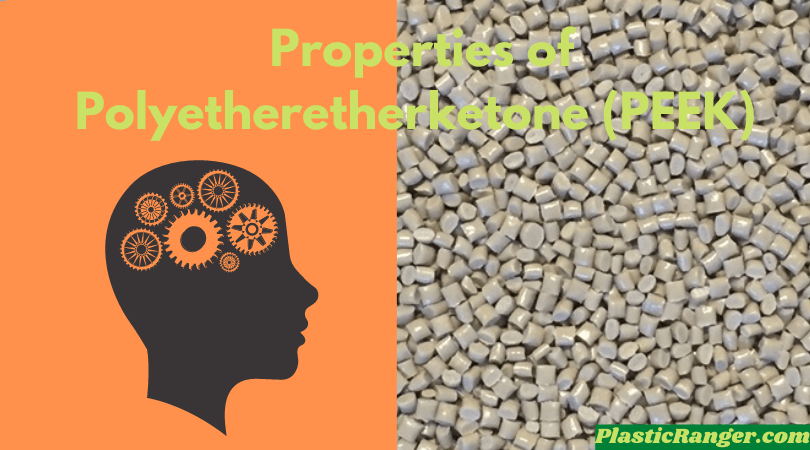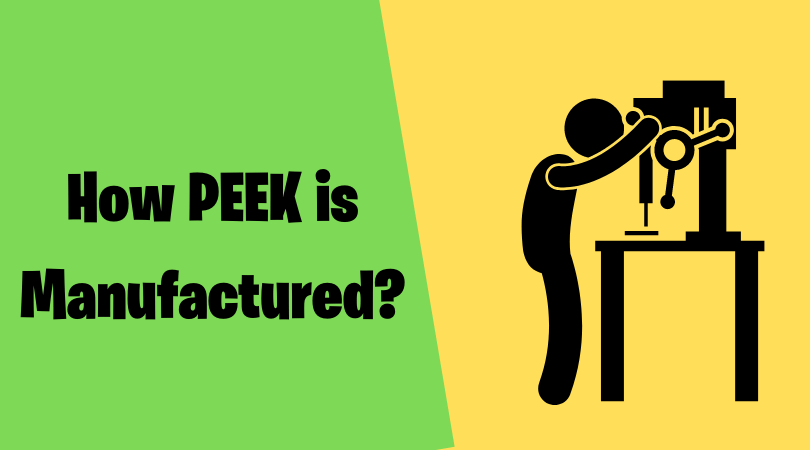There is a high demand for rigid engineering thermoplastics for making high-end engineering goods for the automotive and aerospace industries. Let’s check some detailed information about one of the most in-demand thermoplastics in the manufacturing sector.
What is PEEK Material?
Polyetheretherketone, or PEEK, is a semi-crystalline, high-performance, rigid engineering thermoplastic material with various properties and excellent resistance to harsh chemicals.
PEEK material has been commercially available since the 1980s; there’s no looking back. Remarkable mechanical properties, resistance to wear, and fatigue, and high temperatures up to 260°C make PEEK one of the most resilient and highly utilized thermoplastic materials in plastic industries.
It is one of the smoothest materials for processing in almost every vertical; however, it is mainly utilized in industries like oil and gas, aerospace, automotive, electrical, biomedical, and semiconductor applications because of its resilient properties.
Polyetheretherketone can be processed in traditional plastic manufacturing methods like injection molding, extrusion molding, compression molding, etc.
Properties of Polyetheretherketone

Here are the specific properties of PEEK:
| Property | Unit | Value |
| Physical Properties | ||
| Density | g mL-1 | 1.33 |
| Melting Point | °C | 343 – 387 |
| Coefficient of Thermal Expansion x 10-5 | cm / (cm °C) | 4.5 – 5.5 |
| Thermal Conductivity | W / mK | 0.29 |
| Heat Deflection Temperature, 1.8 MPa | °C | 152 – 172 |
| Rockwell Hardness, M Scale | – | M100 – M124 |
| Mechanical Properties | ||
| Tensile Modulus at 23 C | MPa | 3725 |
| Tensile Strength, Yield at 23 C | MPa | 100 – 115 |
| Tensile Strength, Break at 23 C | MPa | – |
| Compressive Strength | MPa | 120 |
| Flexural Modulus | MPa | 4065 – 4275 |
| Break Elongation | % | 15 – 45 |
| Yield Elongation | % | – |
| Izod Unnotched | kJ / m2 | No breaking |
| Electrical Properties | ||
| Dielectric Strength | V/mm x 104 | 2.5 – 3.3 |
| Volume Resistivity | Ohm-cm | – |
| Dielectric Constant @ 1 MHz | – | 2.8 – 3.3 |
| Dissipation Factor @ 1 MHz | – | 0.001 – 0.005 |
| Other Properties | ||
| Mold Shrinkage | % | 1.0 – 1.3 |
| Processing Temperature | °C | 370 – 400 |
| Water Absorption, 24 hr. Immersion | % | 0.05 – 0.2 |
- PEEK exhibits exceptional creep resistance, making it highly desirable in long-term mechanical stress resistance applications. When subjected to tests involving both flexural and tensile forces, this polymer demonstrates an unparalleled balance of multiple mechanical properties. These include the ability to withstand high loadings over a prolonged period without succumbing to residual damage, thereby retaining its structural integrity.
- PEEK is also notable for its robust tensile strength, which remains impressive even at elevated temperatures up to 299°C. The plastic is highly recommended to be reinforced with carbon fibers to optimize its performance. When properly reinforced, elevating the tensile strength parameters from 25,000 to 30,000 psi is practically achievable, allowing for enhanced material resilience.
- Beyond mechanical strengths, PEEK also possesses favorable insulating properties. These insulating capabilities are stable and reliable across various temperature ranges and environmental conditions, making them versatile for electrical applications.
- Furthermore, PEEK’s unique crystalline structure contributes to its high resistance to diverse liquid mediums. This crystallinity also delivers excellent fatigue performance, enabling the material to withstand cyclic loading conditions over extended periods without failure.
- The polymer’s geometry exhibits a spiral-like configuration and is conducive to effective glass or carbon fibers reinforcement. This enhances its thermal conductivity significantly, offering additional advantages in applications that require good thermal management.
- In addition to its benefits for manufacturers due to its processability, PEEK is also remarkably eco-friendly. It possesses a V0 flammability rating at a thickness of 1.45 mm and a Limiting Oxygen Index (LOI) of 35%. Compared to other mainstream thermoplastics, PEEK generates relatively lower amounts of toxic gases and smoke, making it a safer alternative in environments where flammability and toxicity are concerns.
Interesting Read – What is PETG Material? | The Definitive Guide
Key Benefits of PEEK

- PEEK’s toughness, rigidity, and excellent fatigue resistance make its strength comparable to alloys.
- It has excellent sliding properties making it suitable for rigorous applications with low coefficients of friction and abrasion.
- Terrefic chemcial and corrosion resistance.
- PEEK boasts one of the best flame resistance properties of most other thermoplastics, with a size of 1.45mm; it doesn’t need any flame retardants.
- Peeling resistance also increases PEEK’s applicability in harsh conditions and makes it easy to make with these wires and magnet wires.
Limitations of PEEK

As discussed above, everything about PEEK seems perfect, but that’s false. It has excellent properties and multiple applications and has some limitations that need to be discussed.
- Processing at high temperatures may not be suitable for everyone.
- UV light resistance is relatively low.
- The mechanical properties make the polymer expensive and applicable for high-tech applications. PEEK may even prove a drag for manufacturing simple components.
How is PEEK Material Manufactured?
Bisphenolate salts serve as the cornerstone ingredient in creating PEEK (Polyetheretherketone).
The manufacturing process of PEEK is facilitated through a specific technique known as step-growth polymerization, which is executed using dialkylation methods.
This ensures high control over the polymerization process, allowing for a consistent molecular structure.
The polymerization process defines the inception phase of manufacturing PEEK. Small molecular units, or monomers—specifically Bisphenol-A and 4,4′-difluorobenzophenone—are employed in this phase.
These are combined with a solvent and a catalyst in a specialized reactor vessel, ensuring optimal conditions for polymerization.
After blending these components, the mixture is subjected to high temperatures, approximately around 300°C.
This activates the polymerization reaction until the polymer reaches the targeted molecular weight, offering flexibility in tailoring the material properties.
One of the distinguishing features of PEEK is its rigid aromatic polymer backbone.
This structural characteristic is largely responsible for the polymer’s extraordinarily high thermal transitions and mechanical attributes.
As a result, PEEK is uniquely suited for applications requiring stability at elevated temperatures, often up to 240°C.
Popular Applications of Polyetheretherketone (PEEK)
PEEK Plastic is one of the most utilized thermoplastic materials in aerospace, automotive, biomedical, electrical, etc.
Its might and vigor make it suitable for manufacturing bearings, insulation cables, safety gears, pumps, heavy machine parts, valves, compressors, semiconductors, etc.
Let’s dive into some of the applications in detail.
Aerospace
Products and components of PEEK are steadily replacing aluminum and other metals in the aerospace industry. Many members of the aerospace market have acceptable tolerances and are manufactured more cost-effectively.
- Crucial engine parts can be produced with intricate designs, as Polyetheretherketone can withstand high temperatures—elements requiring high lubrication and inter-biological reactions to different scenarios.
- The polymer can heavily reduce smoke and gas emissions for the interior part. Fire resistance will also play a significant role in providing safety.
- PEEK will benefit the exterior as it can provide excellent rain erosion. Even here, wear and tear resistance properties will come in handy to protect the plane’s exterior part for the long term.
Healthcare
Healthcare products are about safety, comfort, and mobility. Polyetheretherketone can manufacture cost-effective, wear-and-tear chemical and heat-resistant products.
Its applications include dental instruments, safety guards, endoscopes, thermometers, and dialyzers.
- Out of many products that PEEK has replaced, dental syringes, which PEEK manufactures, have become lighter and more cost-effective than aluminum and metal.
- Sterile boxes, mechanical limbs, tooth, and load-bearing implants are other products that PEEK actively manufactures.
- PEEK offers excellent resistance to stress cracks and mechanical strength to deal with chemicals, steam, water, and other available solvents at hospitals and clinics.
Electronics
PEEK plastic already has a significant presence in the electronics market. Household products like Mobile phones, cables, setup boxes, refrigerators, ACs, washing machines, computers, laptops, and electronic wearables.
In some way, all these products or parts of their assembled components are produced using PEEK.
- It can make products with temperature, frequency, and pressure fluctuations.
- Outstanding mechanical properties will maximize safety and comfort while handling silicon wafers.
Apart from those applications, PEEK also takes over other markets like FMCG, hospitality, chemicals, packaging, transportation, and logistics.
Processing of PEEK Material
PEEK plastic can be processed in injection molding, extrusion, and compression molding; however, molding conditions can heavily affect its mechanical properties.
Before processing it, drying for at least 3 hours at 150°C is recommended. By doing that, we can avoid molding defects.
Let’s check on PEEK’s processing with the injection molding method –
Injection Molding
- The advisable mold temperature is 60-190°C for good crystallization and eliminates warping.
- Tweaking at 200°C after crystallization is possible, but only when the proceeding component requires high dimensional stability.
- We advise using injection molding only to manufacture tiny components with tight dimensional tolerances for near-perfect production quality.
- The advised injection pressure is 70-140 Mpa.
- The advised mold shrinkage is Unfilled – 1.2-2.4%, Filled – 0.1-1.1%.
Let’s check on PEEK’s processing with the extrusion method –
Engaging Read – What is TPR Material? |The Defenitive Guide
Extrusion
- The cooling temperature would be crucial in guiding the crystallinity and performance.
- Regarding sheet extrusion for cooling cylinders, the temperature should be 50°C for amorphous material.
- For crystalline and opaque materials cooling cylinder temperature should be 170°C.
The Future of PEEK Material
Global PEEK market share by Application, 2018
Source: GrandWireResearch.com
According to a study by Grand View Research, the global Polyetheretherketone market was estimated at 684.8 million in 2018. And pegged to have a CAGR of 7.2% from 2019 to 2026. Indeed, things will change drastically because of the Covid-19 pandemic.
However, the medical industry’s push (due to the pandemic) and impressive growth in the automotive segment are due to an increase in demand for lightweight, fuel-efficient, and less-pollution-creating vehicles.
North America, Europe, and Asia-pacific are the biggest consumers of PEEK and will further push the growth. Asia-Pacific is the fastest-growing region for plastic processing, let alone Polyetheretherketone, because of increased manufacturing spending and FDI.
Fascinating Read – What is Bakelite?: The Plastic That Changed the World
FAQs

Below are the frequently asked questions on PEEK material properties and PEEK tensile strength. Let’s dive deep to learn more.
Why is PEEK plastic so expensive?
Often manufacturers get surprised by the high price point of the material. The price is said to be high compatibility with CNC milling machines.
Is PEEK used in food applications?
All the PEEK grades are compliant with FDA regulation 21 CFR 177.2415. So it is safe and secure for repeated food contact.
Can we 3D print from PEEK?
PEEK can be 3D printed in the temperature range of 370°C to 450°C. The bed temperature is standard at 120°C. It should be noted that it takes a bit more time with PEEK 3D printing than with other materials, but if enough time is spent, the quality of the products will not disappoint.
How strong is peek?
PEEK is a strong material with a GPa of 3.6 and a tensile strength of 90 to 100 MPa.
What is the melting point of PEEK?
343°C – the melting point of PEEK.
Suggested Read
- Plastics Vs. Polymers | What are the Differences?
- Top 10 High Impact Resistant Plastics
- What is Hardness in Plastics? An In-Depth Guide
- What is PVDF (Polyvinylidene Fluoride) | A Detailed Guide
- 6 Best Plastic Molding Techniques | A Complete Analysis
- 7 Types of Plastics | An Helpful Illustrated Guide
Final Words
Summarizing everything, PEEK (Polyetheretherketone) is a high-performance thermoplastic distinguished by its unique combination of mechanical, thermal, and chemical properties. With exceptional creep resistance, tensile strength up to 299°C, and versatile insulating capabilities, it excels in demanding applications.
Its robust aromatic polymer backbone enables high thermal stability, often up to 240°C.
Reinforcement with carbon fibers further enhances its attributes. Additionally, PEEK is eco-friendly, exhibiting low flammability and toxic gas emissions. These qualities make it an ideal choice for the aerospace and healthcare industries.
I hope you liked the article. I would appreciate your sharing our reviews in the comment box.
Quick Navigation



PEEK is certainly impressive at high temperatures, but how does the strength go down with temperature? Is there a Strength vs Temperature graph? All the way to 250 C?
TIA